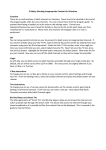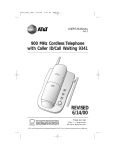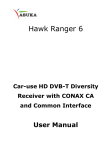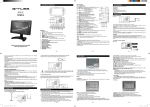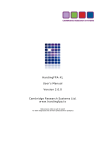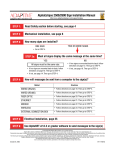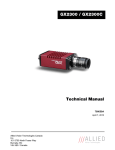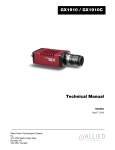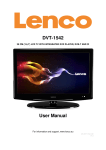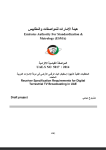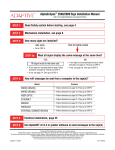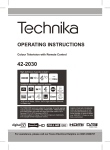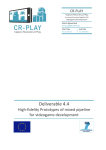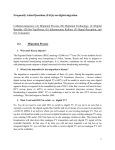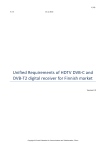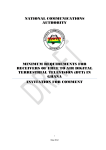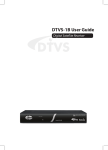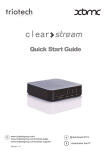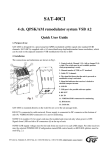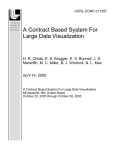Download Freeview HD iDTV specification v3.0
Transcript
Free to Air Digital Terrestrial Receiver (iDTV) Requirements Profile For New Zealand Free to Air Digital Broadcasting Version 3.0 nd Date: 22 September 2014 © Freeview Limited 1 / 39 Table of Contents 1. 2 3 4 5 Introduction ................................................................................................................................................................. 3 1.1 Document History .............................................................................................................................................. 3 1.2 Proposition......................................................................................................................................................... 3 1.3 New Specification Requirements Introduction .................................................................................................. 4 1.4 Purpose .............................................................................................................................................................. 5 1.5 Scope ................................................................................................................................................................. 6 1.6 Glossary ............................................................................................................................................................. 6 1.7 References ....................................................................................................................................................... 10 Overview ................................................................................................................................................................... 11 Receiver Profile......................................................................................................................................................... 13 Key Elements of Software ......................................................................................................................................... 37 4.1 EPG ................................................................................................................................................................. 37 4.2 Subtitles ........................................................................................................................................................... 37 4.3 Interactive Services.......................................................................................................................................... 37 4.4 Software Upgrades........................................................................................................................................... 37 4.5 Logical Channel Numbering ............................................................................................................................ 38 NZ specific additions to MHEG 1.06 UK Profile ..................................................................................................... 39 © Freeview Limited 2 / 39 1. Introduction 1.1 Document History Version Date Author Details 1.0 18/12/06 S.McBride Release for manufacturer review and feedback as part of Request for Proposal. 1.1 13/06/07 S.McBride Updated With Manufactures Feedback and removes the requirement for H.264 AVC SD Receivers 1.2 16/08/07 S.McBride Updated with further feedback from manufactures, changed to an NIT based scan and amended minor errors in ver 1.1 1.3 20/12/2007 S.McBride Final Release to Manufactures 1.4 11/9/2009 S.McBride Updated Specifications encompassing HD MHEG and MHEG Interaction channel. All changes from ver 1.3 have been highlighted. 2.0 25/5/2010 S.McBride Official Release to Manufactures References the new D-Book 6.2.1 MHEG ICEncryptedstreamExtension and LifecycleExtension 1.2 2.1 30/8/2011 T.Diprose Updated Network Interface requirement. All changes from ver 2.0 have been highlighted in green. 2.2 30/5/2014 G. Newman General updates and the inclusion of the HbbTV middleware. All changes from version 2.1 have been highlighted in blue. 3.0 16/9/2014 G. Newman Updates relating to the EIT schedule population within the FreeviewNZ DVB-SI. All changes from version 2.2 have been highlighted in pink. Proposition This baseline Profile, which is based upon open standards, is for a high definition (HD) iDTV (integrated Digital Television) for reception of ‘free to air’, or unencrypted services. The Freeview DVB-T platform will not certify H.264 AVC SD only receivers. Items in this specification are divided into ‘Required’ and ‘Optional’ categories. Where a feature is stated as ‘Required’, its inclusion is necessary for the achievement of a minimum compliance with Freeview transmission requirements. Additional Optional functions may be added by the vendor to enhance the consumer proposition and these will be welcomed by Freeview. In order to be compliant, where a feature is © Freeview Limited 3 / 39 ‘Optional’ and is included in an offered receiver design, the optional feature must be implemented in accordance with the associated referenced standards. This specification is not a comprehensive list of all relevant standards relating to consumer equipment that can provide digital terrestrial reception but rather a list of those standards considered relevant to Freeview requirements. The profile is based upon open standards predominantly Digital Video Broadcasting (DVB) standards and the UK DTG D-Book or includes open implementations which are in use on the UK DTT platform. Changes and additions have been made in this document to suit the required digital terrestrial platform in New Zealand. This most notably, includes requirements for H.264 AVC decoding (not MPEG-2) and high definition video resolution output as well as HbbTV v1.5 (ETSI TS 102 796 v1.2.1) 1.3 New Specification Requirements Introduction FreeviewNZ have implemented the ETSI TS 102 796 v1.2.1 specification for HbbTV to be the new middleware for iDTVs. HbbTV provides mechanisms for the viewer to access applications delivered via both broadcast carousels as well as bi-directional IP communications over the broadband delivery network. The application, most often initiated from the broadcast service, allows the viewer to navigate between both broadcast and broadband platforms to receive enhanced A/V content and other services. The system architecture is described in ETSI TS 102 796 v1.2.1 and the broadcast signalling is described in ETSI TS 102 809 v1.2.1. It is FreeviewNZ’s intention to mimic the Freeview Australia adoption of the HbbTV v1.5 specification as laid out in Free TV Australia’s OP-61 document. This will ensure that New Zealand requires minimal customisation and can take advantage of the manufacturer receivers that are destined for that and other international markets. There is currently no intention to deviate from the Free TV OP-61, ETSI TS 102 796 v1.2.1 and ETSI TS 102 809 v1.2.1 specification. It is a requirement that all IP enabled iDTV’s, whether via ethernet or wireless communications, implement the HbbTV v1.5 specification as laid out in the ETSI TS 102 796 v1.2.1. Non IP enabled iDTV’s may choose to either a) implement the HbbTV v1.5 specification as laid out in ETSI TS 102 796 v1.2.1 b) or implement the MHEG-5 v1.06 specification or c) not implement a middleware solution at all. If a manufacturer of a non IP enabled iDTV chooses to not implement either the HbbTV or the MHEG-5 middleware, the EPG data will be limited to that which is broadcast within the EIT schedule sub-tables. Currently, this is limited to the next four events for each service, after which the events are defined only by the short_event_descriptor (all of which will consist of a “.”) and two content_identifer_descriptors defining the Series and Programme CRIDs for that event. FreeviewNZ are now fully populating the DVB SI EIT schedule with 8 days worth of data. The EIT schedule information should be made available via the “EPG” or “Guide” button on the Freeview remote control. FreeviewNZ have implemented the ability for Huffman compression to be applied to the broadcast DVB SI strings in order to reduce bitrate usage. FreeviewNZ will initially be only applying Huffman compression to the EIT schedule short_event_descriptor. The receiver will be required to store 2 Huffman compression lookup tables as they will not be broadcast. Refer to the FreeviewNZ Transmission Rules v2.5 for more details. All Freeview NZ receivers must adhere to the standards referenced in this document as well as the FreeviewNZ DTT Transmission Rules v2.5. © Freeview Limited 4 / 39 1.4 Purpose The purpose of this document is to describe the requirements for a Freeview certified iDTV for New Zealand and to refer to detailed specifications that are required for conformant implementation. The profile is in the form of a hardware specification outline, together with an overview of software requirements. The software is to be routinely capable of being upgraded via OAD SSU. A ‘Response’ column is included in section 3 to enable detailed feedback on each requirement in the specification if the manufacturer wishes to advise Freeview of its products conformance or any variation from the stated function. © Freeview Limited 5 / 39 1.5 Scope The document sets out to identify the baseline functional specification of a H.264 AVC HD iDTV only. It does not specify the requirements of an iDTV which is SD format only or SD STB, which will not be certified for use on the Freeview DVB-T network. H.264 AVC HD Freeview digital terrestrial receivers and Personal Video Recorders (PVRs) [see separate specifications] are outside the scope of this document. It is intended that a terrestrial receiver conforming to this profile should comprise part of a domestic installation, in conjunction with an external, fixed wideband terrestrial UHF antenna input. It is the aim of the specification to ensure that the Freeview approved receiver in New Zealand satisfies the minimum requirements of each broadcaster. The receiver will operate as defined in the “Freeview Transmission Rules for Freeview DTT Network (New Zealand)” document. In the initial launch of DTT in New Zealand there will be 3 FTA DTT multiplexes with a future provision for a further 2 covering Bands IV and V of the UHF Frequency range. The receiver is to search and decode all multiplexes in these bands. 1.6 Glossary AFD Active Format Descriptor AIT Application Information Table AC-3 Dolby Digital (5.1 Channel) CVBS Composite Video Blanking and Synchronization CENC Common Encryption DASH Dynamic Adaptive Streaming over HTTP DRM Digital Rights Management D-Book See technical standards listed elsewhere in this document BER Bit Error Rate C/N Carrier to Noise Ration CVBS Composite Video Baseband Signal © Freeview Limited 6 / 39 DTT Digital Terrestrial Television DVB Digital Video Broadcast organisation DVB-T Digital Video Broadcasting-Terrestrial DTG Digital Television Group – a UK digital television industry organisation EBU European Broadcasting Union EPG Electronic Programme Guide EIT Event Information Table FEC Forward Error Correction Freeview Consumer Brand and company name of the service provider in NZ FTA Free to Air HDCP High-Bandwidth Digital Content Protection HDMI High-Definition Multimedia Interface HDTV High Definition Television HbbTV Hybrid Broadcast Broadband Television IRD Integrated Receiver Decoder iDTVs Integrated Digital Televisions A standard devised for the middleware for interactive services. MHEG MHEG-5 stands for “Multimedia and Hypermedia information coding Expert Group” May Indicates an event or provision which is permitted, but not mandatory MP@HL Main Profile at High Level MP@ML Main Profile at Main Level MPEG Moving Pictures Expert Group Must Indicates that a third party must comply to ensure correct operation (present tense) Indicates an existing provision © Freeview Limited 7 / 39 NIT Network Information Table OAD Over-Air-Download PAL Phase Alternating Line QAM Quadrature Amplitude Modulation QPSK Quadrature Phase Shift Keying OSD Onscreen Display RF Radio Frequency RS Reed-Solomon SD Standard Definition SDTV Standard Definition Television SFN Single Frequency Network SI Service Information S/PDIF Sony/Philips Digital Interface SSU System Software Upgrade STB Set-Top-Box, which is equivalent to a digital Terrestrial receiver Shall Indicates a mandatory provision Should Indicates a desirable, but not mandatory, provision (TS) Transport Stream: A data structure defined in ISO/IEC 13818-1 UHF Ultra-High Frequency Y/C S-Video Signal YPbPr Wideband Component Video Signal Will Indicates an assumption about existing states or future events © Freeview Limited 8 / 39 © Freeview Limited 9 / 39 1.7 References [D-BOOK] “Digital Television Group: Digital Terrestrial Television, Requirements for Interoperability, Issue 6.2.1” HDMI “High-Definition Multimedia Interface; specification Version 1.3a” HDCP “High-Definition Digital Content Protection System Revision 1.1” EN 300 468 V1.11.1 Digital Video Broadcasting (DVB) Digital Broadcasting Systems for Television, Sound, and Data Services. Specification for service information (SI) in Digital Video Broadcasting (DVB) European Telecommunication Standards Institute ETSI TR 101 211 V1.11.1 Digital Video Broadcasting (DVB); guidelines on implementation and usage of Service information(SI) EN 300 472 v1.3.1 Digital Video Broadcasting (DVB) Digital Broadcasting Systems for Television, Sound, and Data Services. Specification for conveying ITU-R system B Teletext in Digital Video Broadcasting (DVB) Bitstreams. European Telecommunication Standards Institute ETSI. TR 101 190 v.1.2.1 Digital Video Broadcasting (DVB); Implementation guidelines for DVB terrestrial Transmission aspects. EN 300 744 v.1.6.1 Digital Video Broadcasting (DVB); DVB Framing structure, Channel coding and modulation for digital terrestrial television. European Telecommunications Standards Institute. ETSI. © Freeview Limited 10 / 39 ETR 101 154 v1.7.1 Digital Video Broadcasting (DVB); Implementation Guidelines for the use of video and audio coding in Broadcasting Applications based on the MPEG-2 transport stream ETSI 162 Digital Broadcasting Systems for Television, sound and data services, allocation of service information (SI) codes for digital Video Broadcasting (DVB) systems. European Telecommunication Standards Institute. ETSI. ETSI 300 743 v1.3.1 Digital Video Broadcasting (DVB); DVB Subtitling Systems. European Telecommunication Standards Institute. ETSI. 2005 Information Technology – Coding of audio visual objects – part 10 – Advanced Coding [ETSI-MHEG] MHEG Broadcast Profile ETSI ES 202 184 v1.1.1“ NorDig Unified ver NorDig Unified Requirements for Integrated Receiver Decoders for 1.0.2 use in cable, satellite, terrestrial and IP-based networks. Freeview NZ TRANSMISSION RULES FOR FREEVIEW DTT NETWORK VER 2.2 ISO/IEC 14496-10 (New Zealand). ETSI 102 796 v1.2.1 Hybrid Broadcast Broadband Television ETSI 102 809 v1.2.1 Digital Video Broadcasting (DVB); Signalling and carriage of interactive applications and services in Hybrid broadcast/broadband environments Free TV OP-61 Free TV Operational Practice OP-61 – Implementation of Hybrid Broadcast Broadband TV by Australian Free-to-air Television Broadcasters 2 Overview © Freeview Limited 11 / 39 This specification uses the UK DTG D-BOOK (V6.2.1) as its primary reference, in particular Chapter 22, Receiver Requirements, and Chapters 23-27 relating to receiver behaviour and diagnostics with changes/modifications to suit digital Terrestrial broadcasting in New Zealand. © Freeview Limited 12 / 39 3 Receiver Profile The ‘Manufacturers Response’ column in the following table is included to enable a detailed response to each specification item. Item No. 1 Resources Reference/Detail Notes Manufacturers Response The processing power and memory configuration of the receiver must be suitable for the routine operation of FTA HD digital Terrestrial reception (DVB-T), together with the embedded operation of HbbTV v1.5 (according to ETSI TS 102 796 v1.2.1 and FreeTV OP-61) or MHEG-5 Version 1.06. It must also be suitable for the provision of the routine replacement of all software via ‘through-the-air-download”. If the receiver is an IP connected device with a network interface, then it should be suitable for receiving HD multimedia streams via the network interface and applying the necessary DRM to the stream in order to decrypt it; it must also be suitable for the routine replacement of all software via the IP network interface. The performance of the receiver must be such that a user does not feel that the receiver is “sluggish” whilst loading applications. 1.1 DDRAM 128 MBytes Minimum baseline functionality 1.2 Flash 8 Mbytes Minimum baseline functionality 1.3 CPU Processor Speed 200MHz Minimum baseline functionality 1.4 CI PLUS CI PLUS Specification. Ver 1.2. OPT Content Security Extensions to the Common Interface Although there are no encrypted services at present on the NZ DVB-T network. It is expected that in the future that the network will comprise of FTA and pay services. It is therefore highly recommended that all iDTVs (especially those with screen size > 30” diagonal support a CI Plus interface. This interface shall work with the MHEG-5 Profile and or the HbbTV Profile (ETSI TS 102 796 v1.2.1) © Freeview Limited 13 / 39 Item No. 2 Resources Services Summary Reference/Detail Notes Manufacturers Response The receiver must give access to all NZ free-to-view broadcast digital Terrestrial television, radio and enhanced/interactive television services. This must include the capability to efficiently present radio channels, DVB subtitles, Digital Text and Enhanced Broadcast elements of all services. It must present DVB subtitles when broadcast and if requested by the viewer; manage the output video in both widescreen 16:9 and 4:3 picture formats. Where possible receivers should be able to present both subtitles and interactive graphics simultaneously. However, not all receivers may be able to do this, the result being that interactive content will not always be available to viewers that wish subtitles to be presented. 2.1 Time-exclusive services Some services called time exclusive services are only broadcast for part of the day and share their multiplex capacity with other services. During periods when the service is not broadcast, generally it will be replaced by a static MHEG-5 placeholder application. The receiver shall handle the transition between the active and inactive states of a time exclusive service in an orderly fashion, presenting clean transitions into and out of video, audio and inter-active content streams without presentation of any content or application not intended for the selected service. 3.0 Functions 3.1 MPEG4 video H.264 AVC Encoding Req ISO/IEC 14496-10 2005 (Information Technology – Coding of audio visual objects – part 10 – Advanced Coding) 3.2 MPEG2 Video MPEG 2 MP@ML, video resolution, 720x576 (PAL) Opt ISO/IEC 13818 3.3.1 Broadcast HDTV Formats Resolution / Frame Rate/ Scanning / Aspect Ratio 1080p50 1920x1080 / 50 / Progressive / 16:9 © Freeview Limited Opt 14 / 39 Item No. Resources Reference/Detail Notes 1080p25 1920x1080 / 25 / Progressive / 16:9 Opt 1080i25 1920x1080 / 25 / Interlaced / 16:9 Req 720p50 1280 x720 / 50 / Progressive / 16:9 Req Broadcast SDTV Formats Resolution / Frame Rate / Scanning / Aspect Ratio 576p25 720x576 / 25 / Progressive / 16:9 and 4:3 Opt 576i25 720x576 / 25 / Interlaced / 16:9 and 4:3 Req Audio Decoding MPEG1 Layer II /Musicam, audio mode stereo. Sampling Rate 32, 44.1 & 48KHz Req ISO/IEC 11172-3 3.6 Dolby Digital (AC-3) 32, 44.1 & 48KHz – Pass Through on SPIDF. Req DD - ISO/IEC 14496-3 and signalled by TS 101 154, Annex C. 3.7 Dolby Digital (AC-3) 32, 44.1 & 48KHz – Downmix to stereo Pair REQ ISO/IEC 14496-3 and signalled by TS 101 154, Annex C. 3.8 MPEG-4 HE AAC (up to mono and stereo level 2 bitstreams only) Req 3.3.2 3.5 Manufacturers Response All receivers shall conform to Dolby Technical Bulletin 11 for the default use of RF Mode on AC-3 decoding to boost audio levels by 11dB to match with HEAAC levels. ISO/IEC 14496-3. HE AAC audio for services will be encoded for the stereo pair. It is optional for the receiver to decode multi-channel level 4 bitstreams © Freeview Limited 15 / 39 Item No. 3.9 Resources Subtitles Reference/Detail DVB Subtitles. Notes Req All receivers shall be capable of decoding and presenting HD DVB subtitles in accordance to EN 300 743. ETSI EN 300 743 V1.3.1 (rev 7 HD ammendent) DVB subtitles shall be invoked from a suitable labelled remote control key which is always under the control of the receiver. i.e. not under control of receiver group 3 of MHEG 3.10 Display of subtitles during enhanced programming Where both are components of a service, ability to simultaneously present both Subtitles and interactive application graphics if required by viewer preferences. (D-Book sections 17.4 and 15.2) Opt Receivers that are capable of simultaneously presenting both subtitles and interactive application graphics must observe the rules enabling applications to suspend presentation of Subtitles where editorially required. The exception to this is the EPG application which should be invoked by the EPG and have priority even if subtitles have been invoked. 3.11 Teletext The iDTV shall include a Teletext decoder as defined by ETSI standard 300 706 Enhanced Teletext Specification including up to Teletext V1.5. Req If the iDTV has only one suitable labelled ‘TEXT’ key on the remote control then it shall follow the user cases in section 12.1 of the Freeview Transmission Rules Document 3.12 HbbTV EPG An EPG service will be provided via an HbbTV application carried on a bidirection IP connection. This shall be accessed via a configurable RCU button via the application. Req Mandatory for connected iDTVs via an HbbTV Application MHEG-5 EPG An EPG service will be provided via an MHEG-5 application carried via a DSM-CC object carousel. This shall be accessed by the “EPG” or “Guide” Button on the RCU. OPT Optional for non-connected iDTVs via an MHEG-5 Application 3.12.1 © Freeview Limited Manufacturers Response 16 / 39 Item No. Resources Reference/Detail 3.12.2 HbbTV EPG An EPG service will be provided via an HbbTV application carried on a DSM-CC object carousel. This shall be accessed via a configurable RCU button via the application. OPT Optional for non-connected iDTVs via an HbbTV Application OR Digitext A Digitext service provided via the EIT schedule information. This shall be accessed via the “EPG” or “Guide” button on the RCU. OPT Optional for non-connected iDTVs via an HbbTV Application. This data will be initially limited to only the next four (4) events and there is cureently no plans to extend this number. 3.13 Audio Description D-Book Section 4 Opt Design of controls should take into account that many users of audio description are visually impaired. 3.14 Multi-Language Support The receiver is to at least support a primary and secondary audio language based on the ISO 639 language descriptors associated with the audiostreams in the ISO/IEC 13818 MPEG2 transport stream. Req If the secondary audio language is not present then the receiver shall automatically choose the primary audio language 3.15 Widescreen For SD video resolution output format D-Book V4 Section 3.4 and Section 24.2 Req 3.16 Active Format Description Ability to handle 16:9 widescreen and 4:3 picture format changes as detailed in the’ Transmission Rules’ including support for correct aspect ratio and Active Format Descriptors. Opt © Freeview Limited Notes Receivers that are capable of presenting audio description shall provide at least the minimum user controls. (D-Book 6.2.1 including section 4.5.3.1 & 4.5.5) Manufacturers Response 17 / 39 Item No. 3.17 Resources OSD Reference/Detail Minimally Support for a 2 graphics layer model: Image Layer (a full colour layer to display IFrame stills captured from the video decoder) Notes Req Manufacturers Response Video/Still Image layer. There is no requirement to display both still image and motion video at the same time, they are mutually exclusive. Layer to support: Y=8 bit, Cb=8 bit, Cr=8 bit Chroma to be sub-sampled to either 4:2:0 or 4:2:2 Alpha blending need not be supported, but the layer may be shown or hidden. Video Layer (a full colour layer displaying the output of the MPEG video decoder) D-Book ver 6.2.1 section 4.4.1 & 22.3 Layer to support: Y=8 bit, Cb=8 bit, Cr=8 bit Chroma to be sub-sampled to either 4:2:0 or 4:2:2 Alpha blending need not be supported, but the layer may be shown or hidden. OSD/(an 8-bit palletised layer which can display region-based graphics) Each CLUT palette entry to support: Y=8 bit, Cb=8 bit, Cr=8 bit Chroma to be sub-sampled to either 4:2:0 or 4:4:4 Graphics Layer HD MHEG extensions. MHEG-5 HD Graphics layer shall comply with the HD graphics layer as specified in D-Book 6.2.1 section 14.11.1.1 © Freeview Limited 18 / 39 Item No. Resources Reference/Detail Notes Manufacturers Response HbbTV Graphics layer shall support RGBA32 3.18 4.0 Receiver Character Set Tuner / Decoder The main Character set of the receiver shall be the Character code table 00 – Latin Alphabet as specified in IS0 6937. Req In accordance to EN300 744 Rev R1.4.1 Req Req 4.1 RF input connector IEC 60169-2 4.2 Input impedance 75 ohm nominal Req 4.3 Modulation COFDM Req 4.4 UHF Frequency Range 514 MHz to 682MHz Req 4.5 Channel Bandwidth 8Mhz (Signal Bandwidth 7.61MHz) Req © Freeview Limited EN 300 468 Annex A Minimum requirement. 858MHz is acceptable 474MHz to The receiver shall be able to receive carriers within an offset of upto 50KHz from the nominal centre frequency 19 / 39 Item No. 4.6 Resources Input Signal Level / Receiver Sensitivity Reference/Detail Required signal power (dBμV) for 2x10-4 post Viterbi Modulation QPSK 16-QAM 64-QAM © Freeview Limited Notes Code Rate Guassian dBμV ½ 15.2 2/3 17.0 ¾ 18.0 5/6 19.0 7/8 19.8 1/2 20.9 2/3 23.3 ¾ 24.7 5/6 25.7 7/8 26.1 1/2 26.6 2/3 28.8 ¾ 30.4 5/6 31.9 7/8 32.8 Req Guassian assumed transmission Manufacturers Response channel 20 / 39 Item No. Resources Reference/Detail Notes 4.7 Receiver Noise Performance Better than 7dB noise figure in the UHF Band IV and V Req 4.8 Receiver implementation Margin Better than 1.5dB Req 4.9 Interference Immunity Values as stated in Tables 14, 15, 16, 17, 18, 19, 22 and 23 ITU-R BT. 1368-6 document Req 4.10 FFT Size Receiver shall be capable of detecting and presenting services transmitted using 2K and 8K carriers. Req 4.11 Demodulation QPSK, 16 QAM and 64 QAM Req 4.12 Forward Error Correction Codes ½, 2/3, ¾, 5/6 7/8, Auto Req 4.13 Guard Interval Tu/4, Tu/8, Tu/16, Tu/32 Req 4.14 SFN Operation There shall be regions mainly in metropolitan areas of New Zealand where SFN will be in use. Req 4.14a Tolerance to Equal Amplitude SFN Signals The receiver shall continue to correctly demodulate and decode the DVB-T signal in an SFN environment when there are two or more signals of equal amplitude present at the receiver input, provided the maximum time difference between the signals is less than 90% of the guard interval. It is assumed the amplitude of each signal is greater than that specified in 4.8 Req © Freeview Limited Manufacturers Response With reference to C/N values given in the D-Book, section 9.12, for all modulation and code rates listed. As specified by EN 300 744. TS 101 191 V1.4.1 (06/04) Mega-frame for Single Frequency Network (SFN) synchronization 21 / 39 Item No. Resources Reference/Detail Notes 4.14b FFT Window Positioning Strategy Manufacturers are requested to advise of which of the 5 generic strategies described in [EBU SFN Receiver Paper] is used to synchronise the start of the FFT time window when there are several SFN signals present at the receiver input. This information is requested to assist Freeview in modelling SFN coverage only. Opt 4.15 Scanning for Multiplexers On the initial scan the STB shall perform an automatic scan based on the NIT information or a full UHF based auto scan. It shall find all DTT multiplexers within its cell and shall tune in to the correct DVB structure, channel coding, modulation and shall display all services. Req After a scan the channel list shall contain only valid channels currently active on the network. Manufacturers Response [EBU SFN Receiver Paper] "OFDM Receivers - Impact on coverage of intersymbol interference and FFT window positioning", R.Brugger & D.Hemingway, EBU Technical Review, July 2003 The receiver shall not perform a ‘scanAdd’ function thereby leaving old services within a channel list. It addition to an automatic search it shall be possible to perform a manual search where the channel number (id) or frequency is entered. New channels shall be added to the service list. No duplicated channels shall be displayed in the service list. Refer to the FreeviewNZ Transmission Rules v2.5 for clarification around the reception of duplicate services and the Service_Availability_Descriptor. 5.0 Over-Air Software Download © Freeview Limited The receiver shall support DVB System Software Update (SSU) to at least the simple profile. ETSI TS 102 006 refers. Req 22 / 39 Item No. 6.0 Resources Service Information & Selection Summary Reference/Detail Notes Manufacturers Response After the receiver is installed it must offer the viewer all services that may be received in that geographic region compliant with the Freeview regional services requirement. The services being broadcast may change over time. To ensure that the viewer is always able to access all services being broadcast to the selected region, the receiver must detect and reflect to the viewer any such changes with minimal viewer involvement. All services have an associated (Logical) Channel Number. Use of the logical channel number ensures that the viewer becomes familiar with a specific remote control unit button number for each channel. Access to, and use of, accurate service information is essential if the viewer is to enjoy all of the content being broadcast. Receivers must offer a complete list of available unencrypted services and information as carried in ‘DVB S.I. EIT present/following’ about the current and following programmes. A comprehensive multi-day programme schedule will be broadcast in the ‘DVB SI EIT schedule’, as an EPG service to an MHEG-5 V1.06 application and as an HbbTV v1.5 application to the receiver. Refer to the FreeviewNZ Transmission Rules v2.5 for clarification around the reception of duplicate services and the Service_Availability_Descriptor. © Freeview Limited 23 / 39 Item No. Resources Reference/Detail 6.1 Scanning for Services The receiver shall be capable of automatically detecting changes in the services configuration of each broadcast transport stream provided that such changes are implemented by the broadcaster in accordance to the ‘transmission rules’ and are compliant with the DVB-SI standards, [ETSI EN 300 468], [TR 101 211]. The intent of this requirement is to allow the broadcaster to vary the services offering within the relevant broadcast transport stream(s) without the viewer needing to rescan the receiver. Refer to the FreeviewNZ Transmission Rules v2.5 for clarification around the reception of duplicate services and the Service_Availability_Descriptor. Req 6.2 Logical channel numbers Ability to locate, store and handle services with Logical Channel Numbers (LCNs) within the broadcast range of 1 to 799. Req 6.3 Identification of service changes Automatic identification / storage of services or service changes, without the need for user intervention, by reference to the NIT and/or SDT. It shall be without disturbance to the viewer and shall not require a rescan. Req 6.4 Selection via service list The initial displayed service list following a full automatic scan must present services in ascending order of LCN. Req 6.5 Selection via numeric entry Service selection via numeric entry shall always select a service with a corresponding LCN regardless of any viewer favourites Req © Freeview Limited Notes Manufacturers Response If any broadcast service referenced in the SI which does not have an associated LCN is shall be allocated a value in the 800+ LCN range. Any service r referenced in the PSI but without an SI reference shall not be allocated an LCN. 24 / 39 Item No. Resources Reference/Detail Notes 6.6 Hidden services Services identified as “hidden” in the LCN descriptor shall not appear in the service list presented to the viewer. In addition services may shall be selectable by numeric entry. Req 6.7 ESG “Now/Next” ‘Now / Next’ screen guide shall be derived using information from DVB SI EITp/f tables as per EN 300 468 and accessed by the ‘I’ or ‘info’ key on the RCU. Req The presentation of the now/next banner is as per manufactures chosen user interface but it is desirable for the following information to be displayed in the bottom third of the screen. Manufacturers Response The ESG “Now and next” may be displayed when the user changes channels for approx 2 secs and shall also be launched using the i (info) button on the remote control. Current time Start time of now and next programme End time of now and next programme (or duration) Logical Channel Number Channel Name Date © Freeview Limited 25 / 39 Item No. 6.8 Resources EPG ”Schedule” Reference/Detail An 8-day EPG will be provided as an MHEG-5 application. This application will be invoked using the EPG or ‘GUIDE’ button on the remote control if the manufacturer chooses to implement the MHEG-5 middleware. Notes Reg An 8-day EPG will be provided as an HbbTV application. This application will be invoked using a configurable button on the remote control controlled by the application if the manufacturer chooses to implement the HbbTV middleware. Manufacturers Response If a native EPG based is resident in the receiver this can be invoked by the receivers menu system. Note Freeview broadcasts CRID data in the EITschedule and EITpf information for recording devices. See section 5.12 of the Freeview Transmission Rules Document v2.5 An 8-day EPG “Schedule” will be offered via the DVB SI EIT schedule sub-tables which should be accessed via the “EPG” or “Guide” button but only if the manufacturers receiver does not contain an MHEG-5 or HbbTV engine. The manufacturer must comply with the requirements as laid out in Section 1.3 of this document. 6.9 Huffman Compression The receiver will be required to be able to decompress DVB SI strings compressed with Huffman compression. The receiver will be required to store at least two Huffman compression static lookup table. These tables will be of approximately 10KB in size each and will be used by the receiver as a reference library in order for the receiver to decompress the Huffman compressed DVB SI strings according to the FreeviewNZ Transmission Rules v2.5. Req Any DVB-SI data that is stored on the receiver shall be stored in an decompressed format in order to make it available for other entities, such as the HbbTV middleware and the DVB-SI based EPG. © Freeview Limited 26 / 39 Item No. Resources 6.10 TDT / TOT Reference/Detail The receiver shall have a real time clock / calendar running continuously. Notes Req Manufacturers Response EN 300 468 Alternatively the receiver may perform its own 'DST' Computation to calculate the local time The clock shall be updated by the incoming TDT and TOT table in the SI. The receiver shall display the local time. 7.0 Copy Protection 7.1 Digital Outputs The receiver shall provide HDCP digital content protection on the HDMI connector(s). Req 7.2 Content Management If the iDTV has internal storage for recording programmes or an external storage device (USB Pen Drive, HDD, etc.) can connect to the iDTV then it shall provide content management on the signalled content as defined in section 6.2 of the NZ Transmission Rules Document v2.5 or provide a more robust method to secure the broadcast content. Req 8.0 Set-up and I/O 8.1 Easy to use and simple documentation Receivers shall be simple to set up and operate and be provided with clear easy to understand user documentation in line with that requirement. Req HDCP shall be enabled at all times and a user option shall not be provided to disable this function. D-Book Section 26. © Freeview Limited 27 / 39 Item No. 8.2 Resources Support package Reference/Detail Remote control and batteries An easy to understand user manual in English language. Status 9.0 Outputs 9.1 Secondary output Manufacturers Response The following peripheral items should be included within a baseline iDTV package: 8.3 Notes A basic status check may be invoked by a menu driven option or a user selected key. The OSD is to present the reception quality, signal strength indicator, Channel ID and Video and Audio PIDs Req Req Opt The IDTV may offer a secondary video output(s) for connection to a recording device RCA (phono) providing: Component YPbPr Opt Shall only provide SD video resolution (max: 720x576p) output. Shall meet the characteristics in ITU report 624-4 9.2 Secondary Output RCA (phono) providing composite (CVBS) video Opt Shall meet the characteristics in ITU report 624-4 9.3 Secondary output TV SCART with both composite (CVBS) and RGB or YPbPr selectable Audio output (L,R). Opt Shall only provide SD video resolution (max: 720x576p) output. SCART shall support widescreen switching on pin 8. © Freeview Limited EN 50049-1 28 / 39 Item No. Resources Reference/Detail Notes 9.4 Analogue Phono Audio RCA Audio left (Colour – white) & Right (Colour – Red) connectors Opt 9.5 S/PDIF S/PDIF for pass through of Dolby Digital (AC-3) Req Either an Optical and/or Coaxial Digital Audio Output(s) 9.6 Data Interface The receiver shall have a data interface to perform software upgrades and should comply to one of the following options;- Manufacturers Response Manufacture are requested to state connector type Req An RS232 connector 9 pin D sub Universal Serial Bus RJ 45 (Ethernet IEE802.3) Memory Stick 9.7 NETWORK INTERFACE © Freeview Limited To support the HbbTV (ETSI 102 796 v1.2.1) middleware. It shall be of at least 100BaseT (IEEE 802.3u) speed or higher. This does not preclude an additional Wi-Fi (IEEE 802.11b/g/n/ac) network interface. Opt Ethernet or IEEE 802.11 The network interface shall also adhere to the content management usage rules as defined in section 6.2 in the Transmission Rules Document 29 / 39 Item No. 9.8 Resources Remote Control Reference/Detail Notes A Remote Control is to be supplied with the receiver. The manufacture is free to design the remote control but the basic key functions and button labels should be as drawn below. Register 14 Receiver Group POWER 1 2 3 4 5 6 Subtitle 8 9 Prog + Vol - 0 Register 15 Prog - The EPG button will launch the MHEG5 EPG application if an MHEG-5 engine is resident in the receiver. If no MHEG-5 engine is present, the EPG button will launch a schedule service based around the available data broadcast in the EIT schedule subtables. The TEXT or another suitable labelled button on the remote is to initially launch a DVB Teletext service. Info 7 Req Manufacturers Response Vol + The coloured buttons will launch any available MHEG-5 or HbbTV Interactive application when broadcast. All other buttons as D Book Chapter 2 5 “Remote Control Key Labelling Mute The multimedia buttons (Play, Stop, Pause etc) should be able control media stored or made available to the receiver as well as control media being streamed via the HbbTV engine. OK Register 13 TEXT EPG CANCEL RED BLUE YELLOW GREEN Skip Back Skip Fwd Register 16 Stop Play Rewind © Freeview Limited Pause Fast Fwd 30 / 39 Item No. 10.0 Resources Maintenance & upgrade Summary 10.1 Reference/Detail Notes To allow for software changes in either, receivers must be upgradeable in a practical manner, i.e. overair download. The process of upgrading should cause minimal disruption to the viewer. However, to minimise the diversity of deployed software builds and to most efficiently use the available broadcast capacity, the receiver must detect and act upon the broadcast of a relevant software download within 24 hours of its transmission commencing. Req Auto-upgrade Receivers shall be capable of automatic (i.e. not user initiated) software upgrade by over-air download with minimal interruption to the viewer and within 24 hours of availability of the download under normal operating conditions. 10.2 Download mechanism Support for the use of DVB SSU, to at least the simple profile as defined in ETSI TS 102 006 is required. Req 10.3 Downloads in any carrier signal. Receivers shall be able to handle the presence of software downloads in any NIT referred carrier signal. Req Middleware A compliant HbbTV v1.5 ETSI TS 102 796 v1.2.1 engine. Opt 10.4 Manufacturers Response DVB Specification for System Software Update in DVB Systems TS 102 006 ver 1.3.1 Including MPEG DASH and MPEG CENC See 11.3 © Freeview Limited 31 / 39 Item No. 10.5 Resources Reference/Detail Notes Resident EPG A firmware based resident 7 day EPG utilising the data present in the DVB-SI EIT/Schedule in order to present the programme schedule for each service listed within the receiver’s service_list. 11.0 Compliance A receiver shall comply with: 11.1 DVB ETSI standards as listed in the relevant sections of this specification and the DVB-T Freeview Transmission Rules v2.5 document. Req 11.2 Freeview NZ SI/PSI Rules Compliance with DVB-T Freeview Transmission Rules v2.5 document. Req 11.3 HbbTV Receivers with a Network Interface shall support the HbbTV v1.5 specification according to the ETSI TS 102 796 v1.2.1, the FreeTV OP-61 specification and the FreeviewNZ Transmission Rules v2.5 Req © Freeview Limited Req Manufacturers Response Required if the requirements of 11.3 are not met. 32 / 39 Item No. Resources Reference/Detail 11.4 HbbTV DRM Receivers with HbbTV middleware shall implement a DRM solution consisting of at a minimum, either Microsoft Playready or Marlin. A receiver may implement both or additional DRM solutions such as Apple’s FairPlay etc if they so choose. MPEG CENC shall also be supported. © Freeview Limited Notes Manufacturers Response Req 33 / 39 Item No. Resources Reference/Detail Notes 11.5 Energy standards A new Australian and New Zealand energy standard for digital television receivers is currently being drafted. Receivers will need to comply with this standard once ratified. 11.6 AS/NZS CISPR 14-1 EMC emissions Household appliances, electric tools and similar equipment Manufacturers Response Req Manufactures to state consumption in norma standby mode. Req OR 11.7 EN55013 EMC emissions broadcast receivers EN55020 Broadcast receiver product immunity Opt 11.8 AS/NZS 60065:2003 Audio, video and similar electronic apparatus Safety requirements Req 11.9 AS/NZS 61000.3.2:2007 Electromagnetic compatibility (EMC) - Limits - Limits for harmonic current emissions (equipment input current less than or equal to 16 A per phase) Opt 11.10 AS/NZS 61000.3.3:2006 Electromagnetic compatibility (EMC) - Limits Limitation of voltage changes, voltage fluctuations and flicker in public low-voltage supply systems, for equipment with rated current less than or equal to 16A per phase and not subject to conditional connection Opt © Freeview Limited 34 / 39 Item No. 11.11 11.12 Resources Reference/Detail Notes AS/NZS 61000.4.2:2002 Electromagnetic compatibility (EMC) - Testing and measurement techniques - Electrostatic discharge immunity test Opt AS/NZS 61000.4.4:2006 Electromagnetic compatibility (EMC) - Testing and measurement techniques Electrical fast transient/burst immunity test Opt 11.13 AS/NZS 61000.4.5:2006 Electromagnetic compatibility (EMC) - Testing and measurement techniques - Surge immunity test Opt 11.14 AS/NZS 61000.4.112005 Electromagnetic compatibility (EMC) - Testing and measurement techniques - Voltage dips, short interruptions and voltage variations immunity tests Opt © Freeview Limited Manufacturers Response 35 / 39 Item No. Resources © Freeview Limited Reference/Detail Notes Manufacturers Response 36 / 39 4 Key Elements of Software A number of software elements, in addition to those required for basic services, will need to be available or developed prior to launch. They are: 4.1 EPG An 8-day EPG service will be broadcast on all Freeview multiplexes as a DVB SI EIT schedule, an MHEG-5 application as well as an HbbTV application. These Applications will enable the user to navigate through all platform services with the HbbTV application also providing the ability to look back in time and access media via a “reverse” EPG. This reverse EPG will link to a broadcasters own HbbTV VOD application. The user experience of the EPG application should be consistent across all receivers. 4.2 Subtitles According to EN 300 743 v1.3.1– Digital Video Broadcast (DVB); Subtitling Systems. 4.3 Interactive Services These services will be developed utilising MHEG-5 applications or HbbTV applications. 4.4 Software Upgrades A service for providing firmware updates to receivers will be available on the home transport stream using the DVB specification for SSU. 4.4.1. All conforming receivers shall be capable of a systems software update using the simple profile defined in – ETSI TS 102 006. 4.4.2. Manufacturers shall ensure that the receiver offered shall only respond to a unique OUI code, (Organisation Unique Identifier). This means that the receiver offered shall not react to any other OUI from any other manufacturer nor react to any other OUI from the same company which relates to a different model receiver. 4.4.3. The default DVB-SSU mode for receivers shall be with DVB-SSU “enabled”. © Freeview Limited 37 / 39 4.4.4. For Conformance testing manufacturers will be required to deliver two ASI transport streams containing relevant converted binary image files, together with all relevant NIT and PMT data necessary for their receiver to properly undergo a successful DVB-SSU operation. One stream will replace the software in the receiver as demonstrated by a new version number, or some other visible indicator, the other will restore the receiver to its then current configuration. 4.5 Logical Channel Numbering The logical channel numbering specification used is base on the Australian and French variation to the UK specification. For more information see section 6.1 of the “Transmission Rules For Freeview DTT Network ver 2.0” document © Freeview Limited 38 / 39 5 NZ specific additions to MHEG 1.06 UK Profile See section 12 of the “Transmission Rules For Freeview DTT Network ver 2.2” document [END] © Freeview Limited 39 / 39







































